
Natural Science - Year I
Unit 14: Archimedes and Machines

Science Web Assignment for Unit 14
| This Unit's | Homework Page | History Lecture | Science Lecture | Lab | Parents' Notes |
Science Lecture for Unit 14:
Simple Machines
For Class
- Topic area: Machines (practical mechanics, physics of forces)
- Terms and concepts to know: Force, gravity, electromagnetic force, nuclear force, surface tension, buoyancy, plane, lever, wheel and axel, screw, wedge.
- See historical period(s): 300 bce to 200 ce: Hellenistic Science
Outline/Summary
Forces ande Machines
Ancient engineers instinctively used basic machines to move objects from one place to another and to build structures like houses, temples, tombs, roads, aqueducts and tunnels. All of their machines and engines served the same purpose: to aim forces in the right direction to accomplish work. Much later, in the 18th and 19th centuries, physicists using a Newtonian model identified force and work as special concepts.
Forces
We look now in detail at some of the phenomena that Aristotle was trying to deal with when he grappled with how motion occurs. We need to lay the foundations for our concepts of force and our ability to control forces by using simple machines.
We usually think of a force as something that pushes or pulls an object to make it move. Aristotle believed that a force had to act continuously on an object to keep it moving, and a superficial observation of most moving objects would seem to bear this out. Consider mycroft on his merry-go-round If we stop pushing the merry-go-round, it will eventually stop turning, to mycroft's great disappointment. But what "pushes" the planets in motion around the sun?
Force and motion. As we shall eventually see when we study Galileo and Newton, the situation isn't quite as simple as Aristotle thought. Galileo realized that an object in motion will continue in its current state of motion (in other words, keep the same velocity) unless a force from outside the object acts on the object. This tendency of matter to resist change to its velocity is called inertia. Newton realized that a stationary object is really just a special case of motion where speed = 0, so the rule applies to objects at rest as well as objects that are actually moving. For an object to change speed (speed up or slow down), or change direction, there must be a force acting on the object. So our definition of the term force changes a bit.
When we stop pushing the merry-go-round, it should continue in motion forever in the state it was when we stopped pushing. The fact that it doesn't simply means some other force is acting to slow it down, such as friction in the bearings.
The strength of a force determines how fast the change occurs. The direction of the force determines whether the object changes its direction of motion. A force in the same direction will accelerate the object, make it speed up. A force in the opposite direction to the motion will make it deceleration, or slow down. A "sideways" force (one acting at right angles to the direction of motion) will cause the object to change direction, but not change its speed! A force acting at any other angle to the direction of motion will change both the speed and the direction of the object.
The location of the push or pull force acting on an object will the object to move in different ways:
- Translational motion: This occurs when an object changes its location. If you push the center of mass of a pencil, you can shove it across the table.
- Rotational motion: This occurs when one point of an object is fixed, and the rest of the object moves in a circle around it. If you push the point of a pencil laying on a table, it will spin around its center of mass. Forces that cause rotation are called torques.
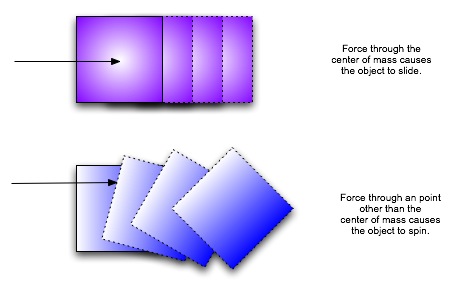
- Circular motion: This occurs when the object moves in a circle, often with an unchanging speed. When mycroft goes around on the merry-go-round, friction between his shoes and the floor of the merry-go-round hold him in place, so that while he moves around at constant speed, he is also under constant acceleration of some force, since he is changing direction every moment.
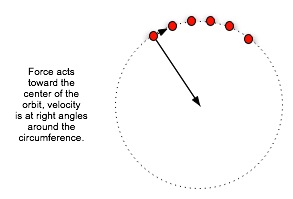
Force, work, energy, and machines. Work is a special form of energy. We can define the amount of energy we need to use to move an object as work, and this amount is equal to the force we use on the object, times the distance we move the object.
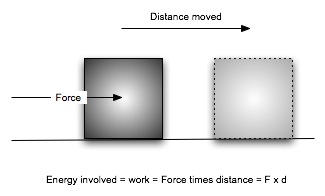
Consider some of the implications of the formula Work = Force x distance. The law of the conservation of energy requires that we have to do the same amount of work to lift a box a foot above the floor, regardless of how we do it. If we increase the distance through which the force works, however, we can reduce the amount of force required to move the box. Sliding the box up and inclined plane takes less force than lifting it straight up.
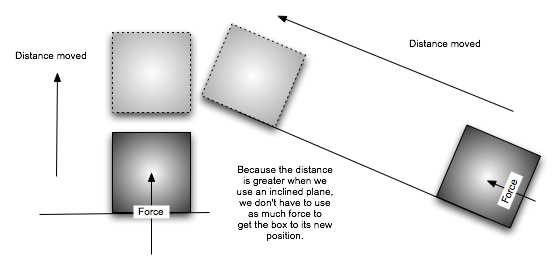
The ratio of the force we force we need to use without a machine compared to the force we need to use with a machine is called the mechanical advantage of the machine. Suppose that we want move a mass from a low shelf to a shelf 1 meter higher. We can lift the mass straight up, or we can slide it up a ramp 3 meters long, at a very low slope. To lift the mass straight up, we would need to use a force 3 meters/1 meter = 3 times greater than sliding it up the ramp. The ramp gives a mechanical advantage of 3.
Another way to look at this is to say that we can do three times the work with the ramp while using the same force it would take us to move the mass straight up. If we can lift a 1 kilogram mass straight up 1 meter using a given amount of force, then we can slide a 3 kilogram mass up our 3-meter ramp with same amount of force. The mechanical advantage 3 of the ramp means we can do three times the work with the same force.
A couple of short notes on Force....
Forces in fluids: surface tension, cohesion, adhesion, and buoyancy. Liquids, particularly water, demonstrate some interesting forces as a result of their composition. The individual bits of water (molecules) attract one another slightly because of an imbalance of electrical forces in each molecule, resulting in surface tension, where the molecules below the surface pull those on the surface down slightly and hold them in place. Surface tension of water is fairly high, allowing insects to "walk on water". If you are fairly careful not to break the surface tension, you can even float a needle on the surface of the water, and observe it bending downward but still supporting the weight of the needle.
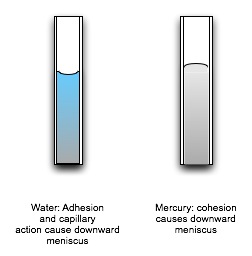
Water molecules are also attracted to the sides of their container, often more strongly than they are to each other. Attraction to unlike substances is called adhesion. In water, adhesion makes molecules of water "crawl up" the sides of narrow tubes, a process called capillary action. We can see this in the downward curve of the water surface or meniscus in a narrow tube, where the edges of the water against the container are higher than the center of the water. Capillary action is important because it allows vascular plants to transport water and nutrients through their systems of phloem and xylem veins. In other liquid elements (like mercury), the atoms of the substance are strongly attracted to each other rather than any container or other substance. This attraction for like particles is called cohesion. The cohesion of mercury gives it an upward meniscus that is higher in the center than around the edges.
An object in water is subject to the weight and jostling of water molecules pushing against it from all sides, including above and below. You'll remember that substances have density, a characteristic that depends on the amount of mass they pack into a given volume (density = mass/volume). A water molecule undergoing the forces of other water molecules all around it tends to stay in one place, assuming there is no current. If we replace some bit of water with another substance of the same density, it will likewise stay in position. If we put in a less dense object, the water will push it up more than it will push down, and it will rise and float. If we put in an substance denser than water, the object will sink. Archimedes recognized this principle of buoyancy, and modern chemists and physicists use it to determine the density and volume of irregularly shaped solids.
Water has a density of 1 gram per cubic centimeter (1 gm/cc3). Here's a list of objects and their densities. Which will float in water?
| Substance | Density in grams/cc3 |
| Milk | 1.030 |
| Isopropyl alcohol | 0.780 |
| Sugar syrup | 1.338 |
| Olive Oil | 0.920 |
| Gasoline | 0.737 |
| Sea Water | 1.025 |
Forces and fixed objects. Forces acting on fixed objects, that is, an object held in place, can make parts of the object move. A force can compress, stretch, bend, or twist matter. The ability of materials to resist this kind of pressure or stretching determines whether the material will be useful for a particular situation. For example, concrete doesn't have very good tensile strength or shear resistance: if you pull on it, or twist it, it will break. But it has very high compression strength, so concrete is a good material where we want something to resist pressure, as in the pillars of a building. We'll come back to forces acting on objects that can't move (or shouldn't move) in our next unit.
Basic forces. So far, we've used examples involving contact forces, forces that act when one object (my hand) exerts a push or pull on another object (the merry-go-round), or when a lever shifts a weight. But the basic forces of the universe fall into four types that can act by changing space, creating force fields that make susceptible objects change their state of motion. The four basic forces are gravity, electromagnetic force, the weak nuclear force, and the strong nuclear force. The latter two operate only over very short distances between subatomic particles inside the nucleus of the atom. Electrical forces repel or attract electrically charged particles, and magnetic forces arise whenever charged particles move. Gravity is the force of attraction that matter exerts on other matter. In the 1970s, research into relationships between these forces show that the electromagnetic force and the weak nuclear force are related in a particular way (Sheldon Glashow, Abdus Salam, and Steven Weinberg won the 1979 Nobel Prize in Physics for their work proving this relationship). Physicists continue to try to find a way to show that all four forces are related somehow, a concept called the Grand Unified Theory.
Simple Machines
Archimedes worked with fluids, developing the study of hydrostatics, and with simple machines, setting the groundwork for the study of mechanics. You have already read about the Archimedes screw, which combines an understanding of both. Archimedes also developed theories about why objects float or sink.
The simple machines of Archimedes have become the foundation of our modern technology. The machines and their permutations and combinations account for all the mechanical parts of automobile engines, tooling lathes, cranes, and robots--all of the moving parts that run our modern machines.
| Simple machine | Purpose | Example |
| Single inclined plane | Increase distance over which force operates. | Ramps |
| Twisted inclined plane | Increases turning distance required to drive into material | Metal screws |
| Double inclined plane | Split objects apart | Wedge: Knife, ax |
| Lever | Change direction of applied force | Pliers, nutcrackers, tongues |
| Fixed fulcrum, third class lever | Decrease friction | Wheel and axle |
| Pulley | Increase distanced through which force acts | Single,double, triple pulleys |
| Gear | Change rate of circular motion | Hand eggbeaters |
Inclined planes. The three examples of the inclined plane are all familiar simple machines. You may not have thought of a screw as an inclined plane, but one way to visualize this is to take a triangular piece of paper (the inclined plane) and wrap it around a pencil, starting with the high side along the pencil length, and ending with the point. The edge of the paper slope marks the "ramp" the screw moves down in penetrating a block of wood.
Knives and axes allow us to change the direction of force slightly to split apart fruit or wood or whatever it is that we need to cut. We swing or push downward (taking advantage of the force of gravity along with our own body weight), and the wedge turns some of the downward force sideways, pushing the edges of our target apart.

Levers. A lever consists of the beam and the fulcrum on which the beam rests. We put a load somewhere on the lever, and apply effort to move the load to a desired position. There are three "classes" of levers, depending on where the fulcrum, load, and effort are placed are placed along the beam. In all three examples below, the lever and effort work to lift the load up.
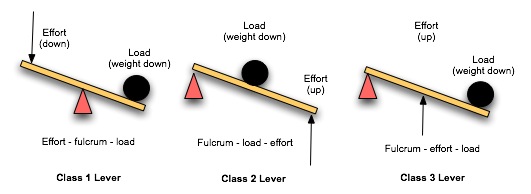

Notice that we really have only a few simple machines: even the wheel can be reduced to a kind of special lever. By combining wheels with axles, we can create pulleys; by twisting inclined planes, we can make screws. By attaching gears to axles, we can get toothed pulleys that perform special timed work--clocks.
- What is the difference between cohesion and adhesion?
- What is surface tension?
- If a small object is completely submerged in water, is there a lot of difference between the force of the water down or up or sideways against the surface of the object?
- What causes an object to float?
- Why would it be a bad idea to try to put out a gasoline fire by pouring water on it?
- What are the major kinds of simple machines?
- Some classifications of these simple machines place all of them in just two classes: levers and inclined planes. Which of the seven listed in your text on p. 131 are levers? Which are inclined planes?
- What kinds of levers are there? How do they differ?
Study/Discussion Questions:
- What is the purpose of a machine?
- How do the basic kinds of machine work?
- How do compound machines work?
Further Study/On Your Own
- The Boston Museum of Science's Leonardo site had an Inventor's Workshop with good pictures of modern versions of the machines.
- The Simple Machines Interactive Website contains links to a number of simple machine simulators, where you can experiment with or even design different machines and put them in motion (without making a mess of Dad's garage work-shelf or Mom's kitchen).
© 2005 - 2024 This course is offered through Scholars Online, a non-profit organization supporting classical Christian education through online courses. Permission to copy course content (lessons and labs) for personal study is granted to students currently or formerly enrolled in the course through Scholars Online. Reproduction for any other purpose, without the express written consent of the author, is prohibited.